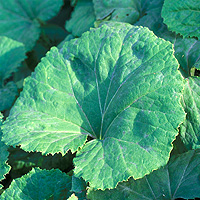health guides
Butterbur
 © Martin Wall
© Martin WallParts Used & Where Grown
Butterbur, or Petasites hydridus, is found in colder, northern regions of Russia and Europe. A species native to the northern United States and much of Canada is Petasites frigidus. All parts of either plant are used, including root, rhizome, leaves, and flowers. Both species are easily confused with their close cousin, Eastern coltsfoot (Tussilago farfara), a plant that looks the same and has similar properties and hazards.
- Reliable and relatively consistent scientific data showing a substantial health benefit.
- Contradictory, insufficient, or preliminary studies suggesting a health benefit or minimal health benefit.
- For an herb, supported by traditional use but minimal or no scientific evidence. For a supplement, little scientific support.
Our proprietary “Star-Rating” system was developed to help you easily understand the amount of scientific support behind each supplement in relation to a specific health condition. While there is no way to predict whether a vitamin, mineral, or herb will successfully treat or prevent associated health conditions, our unique ratings tell you how well these supplements are understood by the medical community, and whether studies have found them to be effective for other people.
For over a decade, our team has combed through thousands of research articles published in reputable journals. To help you make educated decisions, and to better understand controversial or confusing supplements, our medical experts have digested the science into these three easy-to-follow ratings. We hope this provides you with a helpful resource to make informed decisions towards your health and well-being.
This supplement has been used in connection with the following health conditions:
| Used for | Amount | Why |
|---|---|---|
Hay Fever | 1 tablet standardised to contain 8 mg petasin extract two to three times a day for two weeks | Studies have shown butterbur extract to be effective at reducing hay fever symptoms. |
Migraine Headache | Adults: 75 mg twice a day of an extract standardised to contain at least 15% petasins; children: reduce amount according to body weight | Butterbur extract has been shown to significantly reduce the frequency of migraine attacks.
|
Asthma | Adults: 50 mg three times per day for adults; children: 50 to150 mg per day, depending on body size | In one study, asthma patients taking inhaled steroids who also took butterbur extract saw significant improvement in airflow. |
Traditional Use (May Not Be Supported by Scientific Studies)
Traditionally the entire plant was used as a demulcent to soothe a dry, spasmodic cough.1 It was primarily made into a tea, and used only for short periods of time. Using the herb as a tea may have helped reduce the liver’s exposure to butterbur's toxic compounds, as they are not normally water soluble.
Copyright © 2024 TraceGains, Inc. All rights reserved.
Learn more about TraceGains, the company.
The information presented by TraceGains is for informational purposes only. It is based on scientific studies (human, animal, or in vitro), clinical experience, or traditional usage as cited in each article. The results reported may not necessarily occur in all individuals. Self-treatment is not recommended for life-threatening conditions that require medical treatment under a doctor's care. For many of the conditions discussed, treatment with prescription or over the counter medication is also available. Consult your doctor, practitioner, and/or pharmacist for any health problem and before using any supplements or before making any changes in prescribed medications. Information expires December 2024.


 We are proud to announce that
We are proud to announce that  As the market evolves, customers increasingly request a wider variety of omega-3 options for their lipid...
As the market evolves, customers increasingly request a wider variety of omega-3 options for their lipid...  Maintaining healthy glucose levels is crucial for preventing metabolic conditions like diabetes,...
Maintaining healthy glucose levels is crucial for preventing metabolic conditions like diabetes,...  Looking at formulating a new vitamin blend? Discover
Looking at formulating a new vitamin blend? Discover 







































